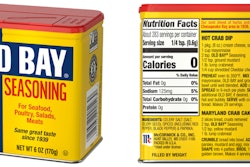The FDA Amendments Act, or FDAAA, is being widely described as the biggest change in the Food and Drug Administration’s powers in about a decade. Yet for all its expansion of FDA’s powers over drugs, which seemed to get all the headlines, the act also makes important changes in the law affecting food makers and packagers.
What’s more, this big new law may not be the end of the story, as a variety of other FDA reforms may be coming soon. Proposals like creation of a single federal food safety agency, and placing new burdens on food importers, are still in play.
The new law fills in gaps in FDA powers in an effort to enhance its ability to protect against unsafe drug products. Yes, believe it or not, with all of FDA’s detailed requirements and specifications over drugs, there were holes remaining, things it still could not do. Congress decided to fill some of them.
So now, under this new law, FDA can make companies conduct clinical trials on drugs even after they are approved. A drug that has been tested on a few thousand people in order to gain FDA approval might turn out to be associated with unforeseen adverse reactions once it’s approved for sale and given to millions. This new provision to require so-called postmarket clinicals would give FDA and the companies a systematic way to study those effects.
The law also renews the programs under which applicants for approvals of new drugs and medical devices pay fees to help pay for the personnel to process the applications.
Though little noticed in news reports, the new law contains a few provisions aimed at bolstering food safety, too, including pet food safety (the latter in the wake of the recent shipments of contaminated pet food from China). The law gets close to giving FDA the power to order food recalls, but sneaks up on it with a new provision requiring food makers to report to FDA when their food might be a danger to health. Now, food makers will have to report to FDA when there is a “reasonable probability that the use of, or exposure to, the food will cause serious adverse health consequences or death to humans or animals.” You wouldn’t have to report the problem if you caused it, discovered it before you transferred the food to anyone else, and fixed it or destroyed the food.
If you fail to report such a Reportable Food, you will have committed a newly created violation of the Federal Food, Drug and Cosmetic Act. Watch for FDA to set up, within a year, a “Reportable Food Registry” to handle these reports.
Further, the law says FDA can require the company reporting a potentially dangerous food to investigate the cause, and to give notification of the key facts to the immediate previous source (think supplier) and immediate subsequent recipient (think customer) of the food.
As a practical matter, if you’re a food company, how could you report those things to FDA and possibly to your suppliers and customers, and not recall the product? So, by requiring companies to give FDA notice, and permitting FDA to require further notices to suppliers and customers and to undertake an investigation of the cause, Congress has, indirectly, given FDA the power to order food recalls in many situations.
It has long been the law that FDA cannot order food recalls, and neither can the U.S. Department of Agriculture order meat or poultry recalls. However, when companies do conduct recalls—voluntarily or under threat of more serious agency actions—the agencies monitor the effectiveness of their efforts. A recent government study found that many food recalls were not completed to the level intended. In this new law, instead of giving FDA explicit power to order food recalls, as some have long advocated, the law puts in place procedural and communications requirements.
Soon after passage of the FDAAA, Congresswoman Rosa DeLauro (D- CT) told me she still will push for giving FDA and USDA explicit power to order food recalls, to better assure protection of the public.
In addition, Congress wants FDA to cooperate with companies and others to collect information about recalls and communicate better with the public about recalls, and also to post food recall information in one place on the agency web site, in a searchable form. (These agencies, and other federal bodies, already maintain a web site called “recalls.gov,” with much or all of this information.)
Also little noticed, the new law contains another provision that at least one FDA-er thinks is destined to be controversial, though its intent is not completely clear from reading it (or maybe because of that). That provision prohibits foods from containing a drug that has been approved as a “new drug,” or a licensed biological product, or even a drug or biological product that has been the subject of clinical investigations, unless, for example, the substances are in there to protect the food, not for therapeutic effect. Sounds like some food makers may have tried sneaking some therapeutic components onto the market in food or dietary supplement form. Don’t be surprised to hear more about this provision in the future.
While this new FDAAA makes changes designed to strengthen FDA powers over drug safety, and to improve food safety, which are admittedly important matters, bigger issues remain. They have to do ultimately with the identity of this important agency, and the priority it is given by Congress. These issues revolve around money and structure.
In recent years, FDA has been rocked by scandals questioning whether it properly protects the public from unsafe drugs, ethics questions about a couple of its commissioners, and new pressures to protect against counterfeit drugs and foods and the potential of a terrorist poisoning.
Observers from multiple corners—government, industry, consumer groups—have long agreed that FDA doesn’t have the money it needs to do a thorough job with all the chores the law requires of it. There’s even a coalition now in which former government officials, industry trade groups, and advocacy groups including consumer advocates have combined to lobby Congress to give FDA more money. Even the industry groups recognize that a properly funded, effective and fair FDA is to their advantage, while a weak, unpredictable, slow-to-act bureaucracy is not.
Beyond funding issues, the perennial question of whether FDA should retain its power to regulate food safety is back on the legislative table again, with more momentum than perhaps ever before. Legislation is now under consideration to combine into a new federal food safety agency FDA’s food safety responsibilities with those of USDA and other federal bodies with a range of food safety-related chores.
If that change in the law comes next, it will make this year’s biggest-change-in-a-decade little more than a historical footnote.
Eric can be reached at [email protected].
Visit his firm’s Web site at www.ericfgreenbergpc.com.
For related articles visit packworld.com/regulatory
























